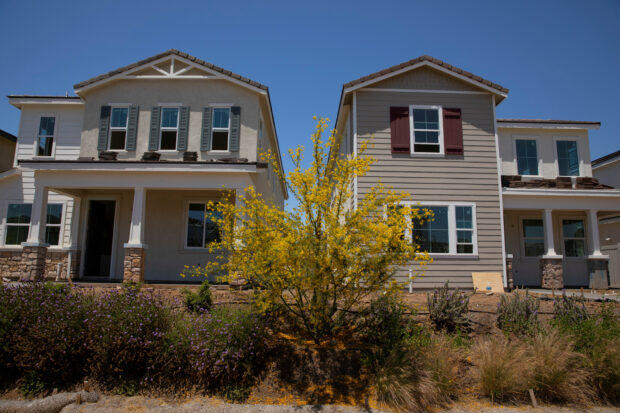
Residential single family homes construction by KB Home are shown under construction in the community of Valley Center, California, U.S. June 3, 2021. REUTERS/Mike Blake/File photo
WASHINGTON — U.S. consumer prices increased solidly in February amid higher costs for gasoline and shelter, suggesting stickiness in inflation that cast some doubts on whether the Federal Reserve would start cutting interest rates in June.
February marked the second straight month of firmer inflation readings. Inflation-weary Americans, however, got some relief from their grocery bills, as food prices were unchanged. U.S. central bank officials, including Fed Chair Jerome Powell have indicated they are in no rush to start lowering borrowing costs.
The higher cost of living is one of the key issues in the Nov. 5 U.S. presidential election.
READ: JPMorgan’s Dimon urges US Fed to wait past June before cutting rates
“Officials want to see some more evidence of a sustained deceleration in prices towards target before they pivot to rate cuts,” said Rubeela Farooqi, chief U.S. economist at High Frequency Economics. “The latest data further reinforce the case for a patient and vigilant approach from Fed officials as they consider future policy decisions.”
Consumer price index
The consumer price index (CPI) rose 0.4 percent last month after climbing 0.3 percent in January, the Labor Department’s Bureau of Labor Statistics (BLS) said on Tuesday.
Gasoline prices rebounded 3.8 percent after declining 3.3 percent in January. Shelter, which includes rents, rose 0.4 percent after advancing 0.6 percent in the prior month.
These two categories contributed more than 60 percent to the monthly increase in the CPI.
Food prices were unchanged after rising 0.4 percent in January. There were decreases in the prices of dairy products, fruits and vegetables as well as nonalcoholic beverages. But prices for cereals and bakery products rose while meat, fish and eggs were slightly more expensive.
In the 12 months through February, the CPI increased 3.2 percent, after advancing 3.1 percent in January.
READ: Fed seen cutting US rates in June, risks skewed toward later move
Economists polled by Reuters had forecast the CPI would gain 0.4 percent on the month and increase 3.1 percent on a year-on-year basis. The annual increase in consumer prices has slowed from a peak of 9.1 percent in June 2022, but progress has stalled in recent months.
Financial markets continue to expect the Fed will cut rates in June. Since March 2022, the U.S central bank has raised its policy rate by 525 basis points to the current 5.25 percent-5.50 percent range.
U.S. stocks opened higher. The dollar rose against a basket of currencies. U.S. Treasury prices fell.
Upward spiral
“Something is wrong with the market’s assessment because services prices continue to spiral upward and commodity prices are no longer falling like they did, which helped to slow inflation’s advance,” said Christopher Rupkey, chief economist at FWDBONDS.
Inflation picked up in January, which was largely blamed on price raises at the start of the year by service providers, which economists said were not fully addressed by the model used by the government to strip out seasonal fluctuations from the data.
READ: Rents boost US consumer prices in Jan
There was also a jump in owners’ equivalent rent (OER), a measure of the amount homeowners would pay to rent or would earn from renting their property, which diverged from rents. That was partly the result of some methodology changes by the government.
The BLS last week held a webinar to discuss the underlying methodology related to the January OER and rent data.
“There is a high likelihood that OER inflation will exceed rent inflation more often moving forward,” said Stephen Juneau, an economist at Bank of America Securities.
“However, we think that much of the 20 basis points divergence was noise and not signal. Rent and OER inflation should continue to moderate over the course of this year, helping to drive core inflation lower as goods price deflation dissipates.”
Excluding the volatile food and energy components, the CPI increased 0.4 percent last month after rising by the same margin in January.
Shelter was also the main driver of the so-called core CPI. Rents increased 0.5 percent after gaining 0.4 percent in January. OER climbed 0.4 percent after surging 0.6 percent in the prior month.
Airfares, vehicle insurance up
Airline fares accelerated 3.6 percent after rising 1.4 percent in January. Motor vehicle insurance cost 0.9 percent more.
There were also increases in the prices of apparel, recreation, used cars and trucks. But the cost of healthcare was unchanged after rising 0.5 percent in the prior month. Hospital services costs decreased 0.6 percent and prescription medication was slightly cheaper. The cost of dental services, however, increased 0.4 percent .
In the 12 months through February, the core CPI advanced 3.8 percent . That was the smallest year-on-year increase since May 2021 and followed a 3.9 percent rise in January.
The Fed tracks the personal consumption expenditures price indexes for its 2 percent inflation target. These measures are running at tamer rates than the CPI.
Though job growth accelerated in February, the unemployment rate increased to a two-year high of 3.9 percent and annual wage inflation moderated a bit.

